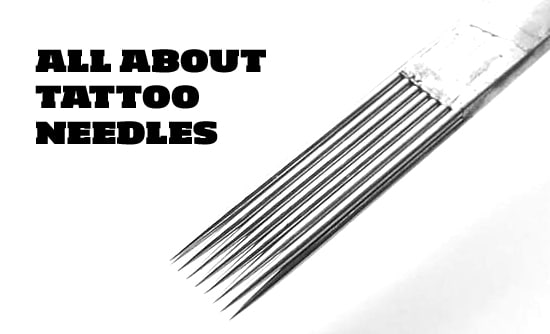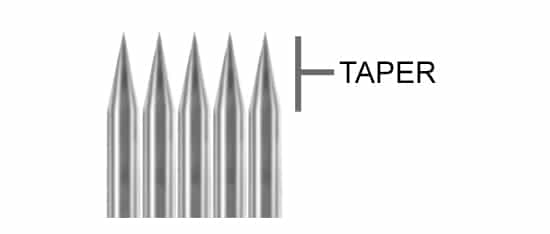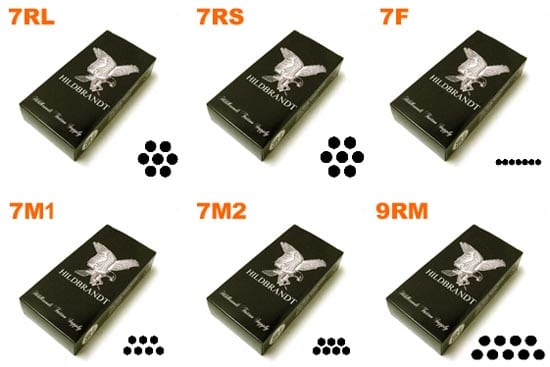
This post is all about tattoo needles, how to use them, which needles do what and what types there are. With the wide array of different types and the lack of standardization in naming for sizes and shapes, it is easy to get confused. The 4 defining properties are the diameter, taper, count and configuration.
Diameter of tattoo needle types
The diameter of tattoo needle types can be found by looking at the first two numbers of the packaging. If you look at your pre-made needle packaging, you will notice it will say something like 1207RL. The two numbers, 12, indicate the diameter. The 4 most common diameters are #12, #10, #8 and #6. #12 is the largest size diameter at 0.35mm. #10 is a diameter of 0.30mm. #8 is a diameter of 0.25mm. #6 is a diameter of 0.20mm. #12, 0.35mm diameter is the most common diameter for most needles. #10, 0.30mm is the most common diameter for ones used for lining.

Taper, Point Length
The taper or point length indicates the shape of the point. A short taper will have a short point. A long taper will have a long point. Different manufacturers have their own specs for what taper they use. A standard short taper is usually 1.5mm. A long taper would be 2.0mm. Extremely long tapers can go as much as 7mm.
Count
The count indicates the number of needles grouped together at the point of the bar. In the example we used earlier, a 1207RL needle, where 12 is the diameter, 7 indicates the count. So a 1207RL needle will have 7 needles soldered to the tip of the bar.

Configuration
Configuration indicates how the needles are grouped together. The configuration determines the shape or pattern of how the ink will go into the skin. So in the example of 1207RL, where 12 is the diameter, 7 is the count, RL, indicates the configuration. RL stands for round liner, a round liner is a formation of needles in a tight circular formation which is used for lining. The other configurations are RS = round shader, F = flats, M1 = weaved magnum, M2 = stacked magnum and RM = round magnum.
Tattoo Needle Types
These configurations make up the different tattoo needle types or groupings. RL or round liner needles grouped together in a tight round formation. RS or round shaders are grouped together in a loose round formation. F or flats are grouped together in a line formation. M1 or weaved magnum are grouped with 2 rows of needles in a weaved formation, so for example a 7M1 will have a bottom row of 4 and an upper row of 3. M2 or stacked magnum are grouped in the same way as M1 but are tightly stacked together hence the name stacked magnum. RM or round magnum are grouped the same way as M1 but the points are arranged in a curved arch.
What Tattoo Needles do What
So what tattoo needles do what? RL or round liner needles are used for lining. RS or round shader are used for shading. Flats are used for areas with geometric shapes and shading. Weaved magnums are used for shading, blending and coloring large areas. Stacked magnums are used for shading, blending and coloring tighter large areas. Both can be used for lining if you turn the needle to the side. This does take a bit of skill to do, so only do it if you have practiced the technique enough or else you may end up damaging the skin. Round curve magnums are used for shading, blending and coloring large areas with less impact to the skin. The needles are made in an arch formation to better deflect the skin when it goes in and out. With a regular magnum, there is potential for the edges of the mag to dig into the skin, with a round magnum, the arch of the needle will allow you to move more freely on the skin without the risk of the edges digging in.
How to use Tattoo Needles
So how to use tattoo needles like rounds, magnums and curved magnums? Rounds are quite straight forward. The larger the area of coverage, the larger count needle you would use. For thicker lines, use a larger count round liner. Pigment dispersal using a magnum is smoother than rounds. A good comparison would be a round liner is a pen while a magnum is a magic marker. Proper use of a magnum takes a bit of practice. The magnum should always hit the skin at an angle. If it goes in straight and not at an angle it will stick into the skin which will cause the needle to jump. Always drag the magnum across the skin by pulling it across. Do not push forward as this will cause the magnum to dig into the skin causing pain and getting the needle caught. Color in a circular motion, a magnum, being wider, will cover more area faster than a conventional round. Wipe the skin often so you can pay attention to the texture while you are using a magnum.